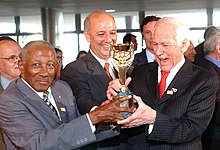Coupe Jules Rimet
The Coupe Jules Rimet ( French for Jules Rimet Cup ) was the trophy of the soccer world championships from 1930 to 1970 . Originally simply as World Cup ( Coupe du Monde ) indicates that he was after the Second World War, at the suggestion of Vice President of FIFA and Chairman of the Belgian Football Association Rodolphe Seeldrayers after the then FIFA Chairmen Jules Rimet in Coupe Jules Rimet renamed.
Appearance
The Coupe Jules Rimet was a 35 cm high statue made of gold-plated sterling silver. It weighed 3.8 kg and stood on a blue lapis lazuli base . On the sides of the base was an engraved gold plaque with the name of the cup and the names of the nine world champions. The statue was designed by the French sculptor Abel Lafleur (1875–1953). Like many earlier trophies, it was made in the shape of a woman; this should represent the Greek goddess of victory Nike . She had upstretched arms with wings. Under the statue there was space for the names of the winners.
The World Cup was procured by Enrique Buero , the then ambassador of Uruguay to Belgium and one of the co-founders of the World Cup, and gave his then fifteen-year-old son Enrique J. Buero ("the Belgian") on the three-week voyage to Uruguay that he and the Belgian national football team took with him undertook.
winner
At the beginning of the first soccer World Cup in 1930 it was announced that the association whose selection wins the cup three times may keep it. When a Brazilian national team won the third World Cup in 1970, the Jules Rimet Cup therefore became the property of the Brazilian Football Association .
-
1930 Uruguay

-
1934 Italy

-
1938 Italy

-
1950 Uruguay

-
1954 Federal Republic of Germany

-
1958 Brazil

-
1962 Brazil

-
1966 England

-
1970 Brazil

This makes Brazil the most common winner of this cup with three wins, followed by Uruguay and Italy with two wins each. The German and English national teams were allowed to hold it in their hands once. The trophy went to South America five times and Europe four times.
Storage locations
According to the rule, the reigning world champion was allowed to keep the challenge cup until the next world championship. During the Second World War he was therefore in Italy; FIFA Vice-President Ottorino Barassi kept it in a shoebox under his bed.
The theft of the Jules Rimet coupe in the run-up to the 1966 World Cup caused a stir . The trophy, which had recently been returned to FIFA by the Brazilian Football Association, was part of an exhibition Sports in Postage at London's Westminster Central Hall when it disappeared on March 20, 1966 while a service was being held in another part of the building . Exactly one week later the trophy was found again; a dog named Pickles found him walking in a front yard in south London.
After the Coupe Jules Rimet had found its permanent place in Brazil after the 1970 World Cup , it was stolen again from an association showcase in Rio de Janeiro on December 19, 1983. Since the thieves had melted down the trophy after investigations by the police, the Brazilian Football Association is now in possession of a copy that was made in Hanau , Hesse and handed over to a Brazilian delegation in 1984 in the German goldsmith's house there .
In the treasury of the German Football Museum in Dortmund, a true-to-original replica of the Coupe Jules Rimet can be seen alongside the original trophies from the 1974, 1990 and 2014 world championships.
successor
The successor to the Jules Rimet Cup is the FIFA World Cup Trophy . It has been the trophy since the 1974 World Cup and, unlike its predecessor, is not awarded, but remains the property and possession of FIFA. The world champion receives a replica made of gold-plated bronze, but this also remains the property of FIFA and must be returned on request.
Trivia
In the song Three Lions by The Lightning Seeds Cup is sung.
Web links
- The FIFA World Cup Trophy , FIFA website
- Cups and trophies - Coupe Jules Rimet - on dfb.de
- The double theft of the Coupe Jules Rimet at einestages.spiegel.de, inserted December 22, 2013
- Stolen World Cup trophy 1966 "What the hell should we do with this thing?"
Individual evidence
- ↑ Photo of the original with lapis lazuli base accessed on www.planetworldcup.com on March 12, 2014
- ↑ Kurt Deswert: Hoe het WK begon in Ixelles . Bruzz of June 20, 2018, pages 28-29.
- ↑ FIFA calendar note: Theft of the Jules Rimet Cup (PDF; 1.4 MB), accessed on December 18, 2008
- ^ Treasury in the German Football Museum. Retrieved June 7, 2019 .
- ↑ www.fifa.com: Information on the new FIFA World Cup trophy
- ↑ Regulations. (PDF; 431 kB) FIFA, May 30, 2011, p. 54 , archived from the original on June 29, 2014 ; Retrieved July 16, 2014 .
